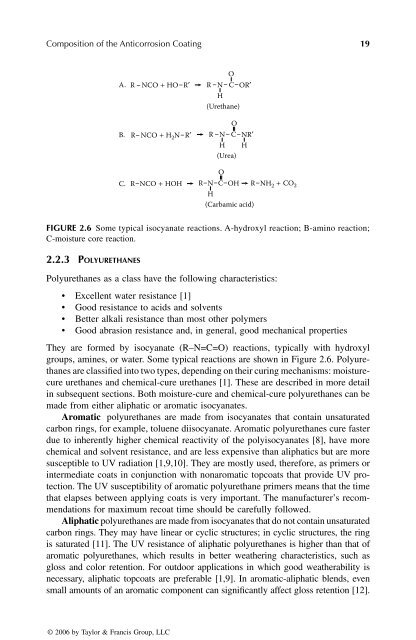© 2006 by Taylor & Francis Group, LLC
© 2006 by Taylor & Francis Group, LLC
© 2006 by Taylor & Francis Group, LLC
Create successful ePaper yourself
Turn your PDF publications into a flip-book with our unique Google optimized e-Paper software.
Composition of the Anticorrosion Coating 19<br />
FIGURE 2.6 Some typical isocyanate reactions. A-hydroxyl reaction; B-amino reaction;<br />
C-moisture core reaction.<br />
2.2.3 POLYURETHANES<br />
A. R NCO + HO R′ R N<br />
H<br />
O<br />
C OR′<br />
(Urethane)<br />
B. R NCO + H2N R′ R N<br />
O<br />
C NR′<br />
H H<br />
(Urea)<br />
C. R NCO + HOH R N<br />
H<br />
O<br />
C OH R NH2 + CO2 (Carbamic acid)<br />
Polyurethanes as a class have the following characteristics:<br />
• Excellent water resistance [1]<br />
• Good resistance to acids and solvents<br />
• Better alkali resistance than most other polymers<br />
• Good abrasion resistance and, in general, good mechanical properties<br />
They are formed <strong>by</strong> isocyanate (R–N=C=O) reactions, typically with hydroxyl<br />
groups, amines, or water. Some typical reactions are shown in Figure 2.6. Polyurethanes<br />
are classified into two types, depending on their curing mechanisms: moisturecure<br />
urethanes and chemical-cure urethanes [1]. These are described in more detail<br />
in subsequent sections. Both moisture-cure and chemical-cure polyurethanes can be<br />
made from either aliphatic or aromatic isocyanates.<br />
Aromatic polyurethanes are made from isocyanates that contain unsaturated<br />
carbon rings, for example, toluene diisocyanate. Aromatic polyurethanes cure faster<br />
due to inherently higher chemical reactivity of the polyisocyanates [8], have more<br />
chemical and solvent resistance, and are less expensive than aliphatics but are more<br />
susceptible to UV radiation [1,9,10]. They are mostly used, therefore, as primers or<br />
intermediate coats in conjunction with nonaromatic topcoats that provide UV protection.<br />
The UV susceptibility of aromatic polyurethane primers means that the time<br />
that elapses between applying coats is very important. The manufacturer’s recommendations<br />
for maximum recoat time should be carefully followed.<br />
Aliphatic polyurethanes are made from isocyanates that do not contain unsaturated<br />
carbon rings. They may have linear or cyclic structures; in cyclic structures, the ring<br />
is saturated [11]. The UV resistance of aliphatic polyurethanes is higher than that of<br />
aromatic polyurethanes, which results in better weathering characteristics, such as<br />
gloss and color retention. For outdoor applications in which good weatherability is<br />
necessary, aliphatic topcoats are preferable [1,9]. In aromatic-aliphatic blends, even<br />
small amounts of an aromatic component can significantly affect gloss retention [12].<br />
<strong>©</strong> <strong>2006</strong> <strong>by</strong> <strong>Taylor</strong> & <strong>Francis</strong> <strong>Group</strong>, <strong>LLC</strong>
















